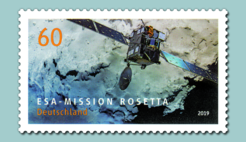Rosetta stamp released in Germany
In Germany, a new stamp pays tribute to the European comet mission Rosetta.
The German postal service “Deutsche Post” has dedicated a stamp to ESA’s comet mission Rosetta. The stamp with a value of 60 cents is officially released today as part of a special series of stamps devoted to topics related to space and astrophysics. In addition to the Rosetta spacecraft, the motif shows part of the surface of Rosetta’s comet Churyumov-Gerasimenko captured by the onboard scientific camera system OSIRIS.

“Seeing the Rosetta mission and with it one of OSIRIS’ s images honored in this way, is a very special moment for us”, says Dr. Holger Sierks of the Max Planck Institute for Solar System Research (MPS) in Göttingen, OSIRIS Principal Investigator. After a ten-year journey through space, Rosetta accompanied comet 67P/Churyumov-Gerasimenko from August 2014 to September 2016 on its way around the sun and explored it from close up. During this time, the OSIRIS camera system, which was developed, built and operated under the leadership of the MPS, captured 70,000 views of the comet.
The current stamp shows a region on the north side of the bizarrely shaped body. "This region has had a decisive influence on our understanding of comets and their development," Sierks explains. When a comet approaches the Sun, frozen gases evaporate from its surface and carry away small and large dust particles. Some of this material cannot escape the comet's gravity field and "rains" back onto the comet's surface. The smooth surface structures seen on the stamp were created in this way. "The northern side of the comet almost resembles a winter landscape, where a blanket of snow covers up sharp contours," Sierks says.
Rosetta is the first space mission to examine a comet at close range for several years. The mission has driven comet research like no other before. German research institutions played a major role in Rosetta. In addition to the scientific camera system OSIRIS, the MPS contributed three other instruments and hardware to several others. In addition, the institute was significantly involved in the development and construction of the Philae landing unit, that touched down on the comet in November 2014.












